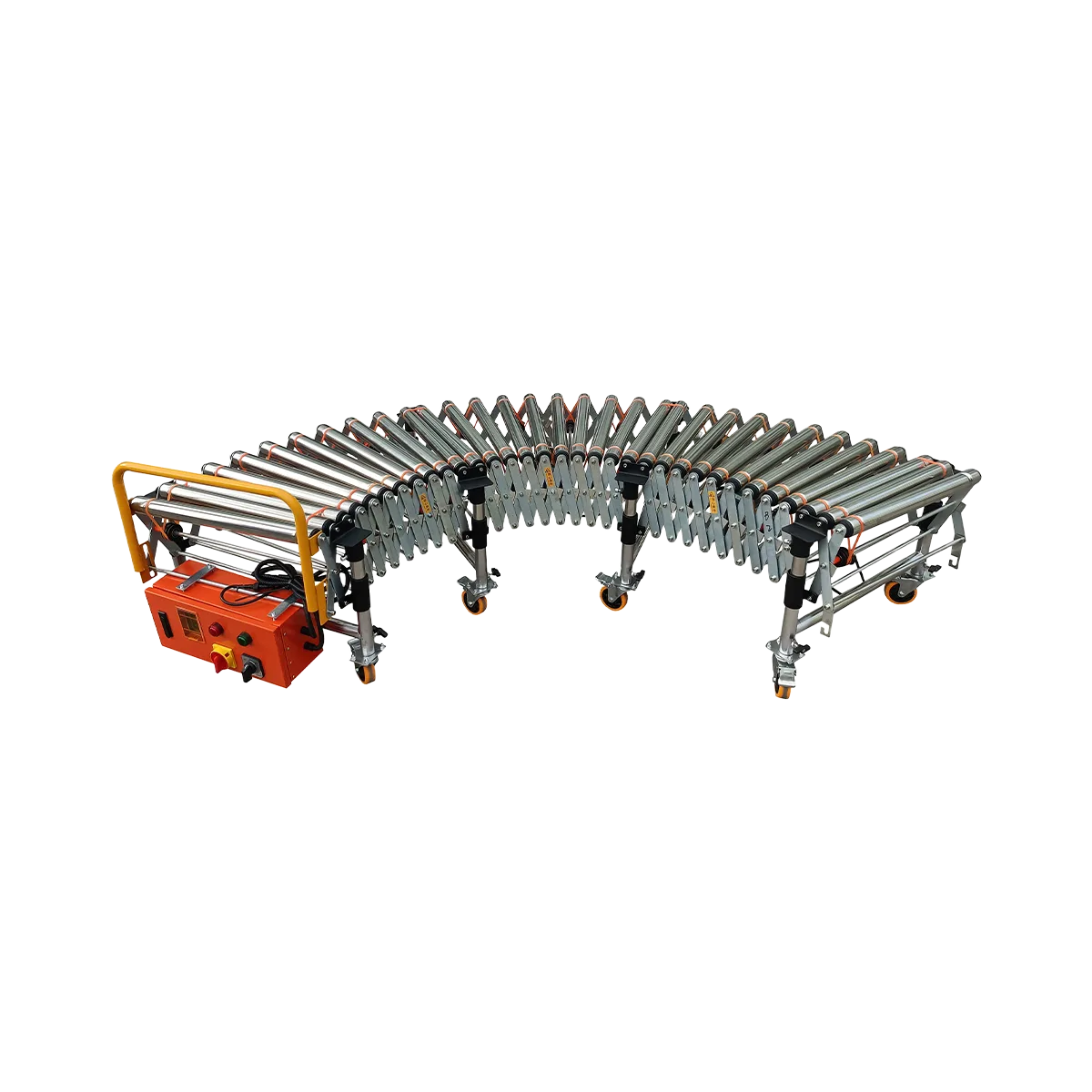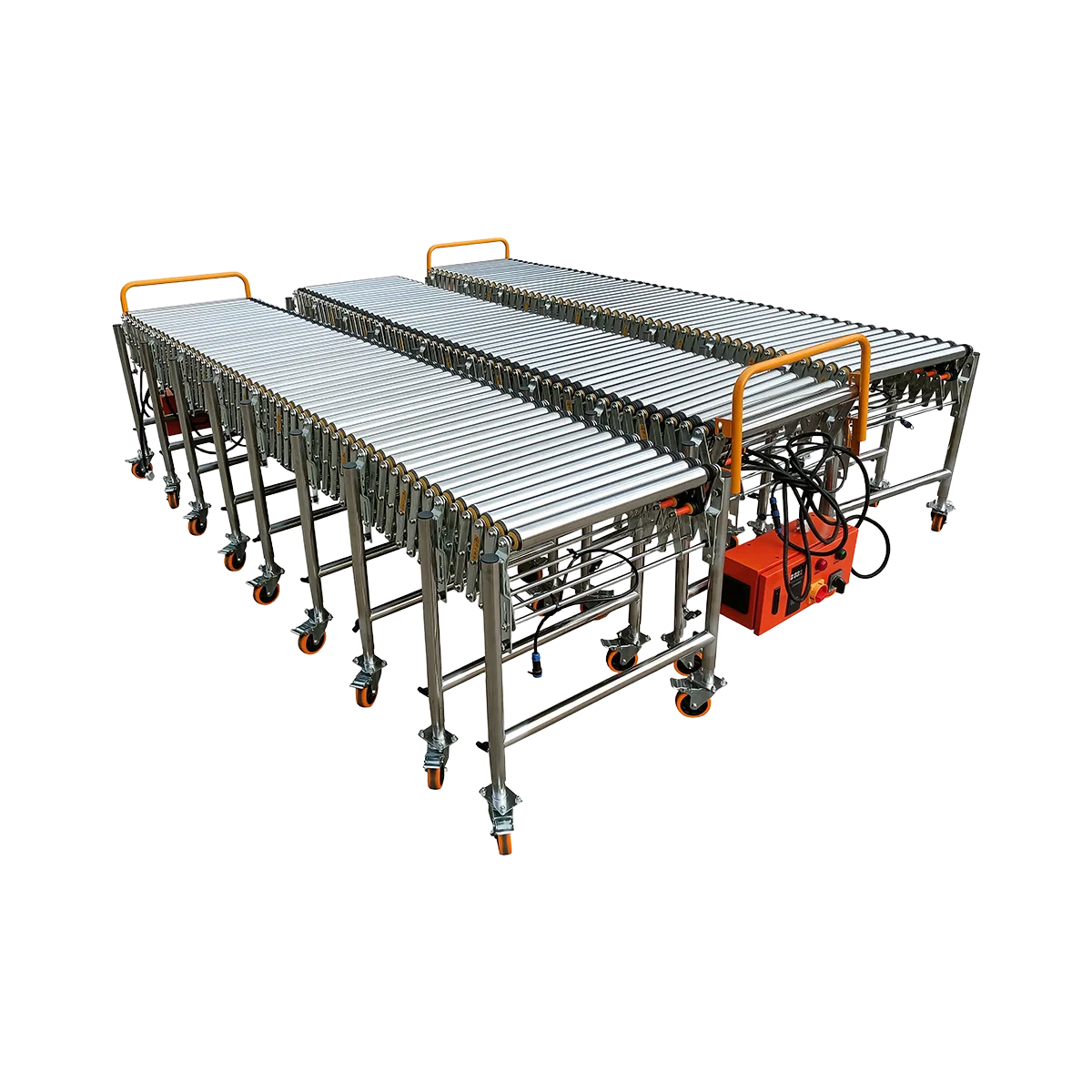How to Load and Unload Boxed Electronics Safely
Related Products
- Powered Roller Conveyor – O-shaped Belt Driven – 1500 mm/SectionCollapsed Length
525 mm
Extended Length1500 mm
Load Capacity80 kg/m
Applicable GoodsFlat-bottomed Goods
- Powered Roller Conveyor – Multi-wedge Belt Driven – 2000 mm/SectionCollapsed Length
700 mm
Extended Length2000 mm
Load Capacity100 kg/m
Applicable GoodsFlat-bottomed Goods
- Powered Roller Conveyor – Multi-wedge Belt Driven – 3000 mm/SectionCollapsed Length
1050 mm
Extended Length3000 mm
Load Capacity80 kg/m
Applicable GoodsFlat-bottomed Goods
In the high-value world of consumer electronics logistics, even minor handling damage can transform profitable products into costly returns. Modern electronics distribution centers face the dual challenge of maintaining efficiency while ensuring the absolute protection of delicate devices – from smartphones and tablets to large-screen televisions and gaming consoles. This article explores best practices for implementing an electronics distribution conveyor system that balances throughput needs with the careful handling these sensitive products demand. By adopting specialized conveyor solutions and handling protocols, distribution centers can significantly reduce damage rates while maintaining the speed necessary to meet consumer expectations for rapid delivery.
The Protection Challenge
Preventing Drops and Impacts
Electronic devices are particularly vulnerable to handling damage during the loading and unloading process:
- Internal component sensitivity: Circuit boards, display panels, and storage drives can fail from even moderate impacts
- Packaging limitations: Retail packaging often prioritizes marketing appeal over impact protection
- Weight distribution challenges: Uneven weight distribution in electronics can cause unexpected shifting during transport
- Connecting cable damage: Ports and cables can be damaged by lateral pressure during handling
- Corner vulnerability: Package corners often receive insufficient protection despite being most exposed to impacts
These vulnerabilities make traditional high-speed conveyor systems problematic for tech product handling. Even a minor 2-3 inch drop between conveyor sections can generate enough impact to damage sensitive internal components, particularly in products with large glass panels or precision mechanisms. This reality forces distribution centers to balance throughput efficiency against product protection requirements.
Maintaining Box Orientation
Beyond impact protection, orientation control represents another critical aspect of safe loading electronics:
- “This Side Up” requirements: Many electronics must maintain a specific orientation to prevent component damage
- Display protection: Flat-screen devices must typically remain vertical during handling
- Battery concerns: Some devices with batteries require specific orientation to prevent internal pressure damage
- Accessory displacement: Improper orientation can cause accessories to shift and damage main components
- Stacking limitations: Electronic product boxes often cannot support weight from above
Without careful orientation control throughout the conveyor system, products can rotate into vulnerable positions. This is particularly problematic during transitions between conveyor sections, where even properly packaged electronics can become misaligned and subsequently damaged.
The Gentle Solution: Naili’s O-Belt Powered Roller Conveyor
After analyzing the specific requirements for handling boxed electronics, the Powered Roller Conveyor with O-belt drive emerges as an ideal solution for gadget warehouse system operations. This conveyor type addresses the key challenges of electronic product handling through several critical features:
Smooth Starts and Stops
The O-belt drive system provides exceptionally smooth acceleration and deceleration characteristics vital for consumer electronics logistics:
- Gradual force application: O-belt system applies traction forces evenly across products
- Minimal inertial impact: Smooth starts prevent products from sliding or tipping forward
- Consistent driving tension: Maintains steady movement even with varying product weights
- No sudden jerks: Eliminates abrupt movements that can damage internal components
- Quiet operation: Reduces vibration that can affect sensitive electronics
With a speed range of 0.3-40 m/min, operators can precisely calibrate conveyor speed to match the specific requirements of different electronic products. Smaller, more robust items might move at higher speeds, while large-screen televisions or delicate components can be transported at more conservative rates.
Controlled Speed for Delicate Items
The variable speed control of the O-belt system allows for precise adjustments based on product sensitivity:
- Product-specific settings: Customizable for different electronic categories
- Zone-based speed control: Creates slower transition areas between conveyor sections
- Gradual speed transitions: Implements gentle speed changes rather than abrupt shifts
- Visual flow management: Maintains appropriate spacing between products
- Synchronized operations: Aligns with packing and quality control station timing
For distribution centers handling mixed electronic products, this speed control functionality allows the creation of handling protocols tailored to specific product categories. A recommended configuration chart helps streamline these decisions:
Speed Configuration by Product Type:
| Product Category | Recommended Speed | Spacing Between Items | Orientation Requirements |
|---|---|---|---|
| Smartphones/Tablets | 15-20 m/min | Minimum 300mm | Vertical, screen facing up |
| Laptops | 15-20 m/min | Minimum 400mm | Horizontal, hinges up |
| Desktop Components | 20-30 m/min | Minimum 500mm | Follow box indicators |
| Large TVs/Monitors | 10-15 m/min | Minimum 800mm | Vertical, screen facing forward |
| Gaming Consoles | 15-25 m/min | Minimum 500mm | Follow box indicators |
The 1500mm extendable sections of the O-belt Powered Roller Conveyor provide excellent flexibility for electronics distribution conveyor layouts, adapting to different warehouse configurations while maintaining gentle handling characteristics.
Setting Up Safe Zones
Impact-Free Transfers
The most critical points in any consumer electronics logistics conveyor system are the transitions between sections. These junctions present the greatest risk for product damage and must be carefully engineered:
- Seamless connections: Ensure minimal gaps between conveyor sections to prevent drops
- Height alignment: Precisely match heights between sections to eliminate impacts
- Transfer plates: Add smooth transition plates where any gap exists
- Speed matching: Synchronize speeds between adjacent sections
- Monitoring points: Position cameras or operators at key transition areas to monitor for issues
For electronics handling, conventional wisdom about acceptable transfer gaps must be reconsidered. While a half-inch gap might be acceptable for robust products, electronics distribution requires virtually seamless transitions, often using specialized bridge plates to ensure continuous support.
Implementation Recommendations:
- Install adjustable-height support legs to enable perfect alignment between sections
- Use level indicators to verify horizontal alignment during setup and periodic maintenance
- Add transition plates no steeper than 7° at any necessary gaps
- Position impact-absorbing material at unavoidable drop points
- Conduct regular inspections of transition points using a test package with impact sensors
Clear Visibility for Operators
A critical yet often overlooked aspect of safe loading electronics is ensuring operators have clear visibility of products throughout the conveyor path:
- Line of sight requirements: Position workstations to maximize product visibility
- Proper lighting: Install diffused, glare-free lighting above conveyor paths
- Color-coded zones: Mark different handling areas with distinct visual indicators
- Digital monitoring: Add cameras at blind spots with displays at operator stations
- Visual alert systems: Implement warning lights for system issues or product jams
This visibility is particularly important for high-value electronics, where visual inspection during movement can identify potentially damaged packages before they progress further into the distribution process. By catching problems early, distribution centers can avoid the substantial costs associated with shipping damaged products to customers.
Operator Station Design Tips:
- Position workstations at a 15-30° angle to the conveyor for optimal viewing and ergonomics
- Keep conveyor height between 750-850mm for comfortable visual inspection
- Install adjustable task lighting that operators can position as needed
- Provide clear sightlines of at least 3 meters in each direction from each station
- Create designated inspection zones with slightly slower conveyor speeds
By combining proper equipment selection with thoughtful workspace design, tech product handling operations can achieve both the efficiency and protection required for modern electronics distribution.
Conclusion
Implementing an effective system for safely handling boxed electronics requires careful consideration of both equipment selection and operational procedures. The O-belt Powered Roller Conveyor system provides an excellent foundation due to its smooth operation, precise speed control, and flexible configuration options that address the unique challenges of electronics distribution conveyor operations.
By focusing on critical factors – particularly impact prevention and orientation control – distribution centers can significantly reduce damage rates while maintaining efficient throughput. The key takeaways for optimizing your electronics handling system include:
- Select conveyor systems specifically designed for gentle handling
- Eliminate impact points, especially at transitions between conveyor sections
- Implement product-specific speed and spacing protocols
- Ensure proper operator visibility throughout the conveyor path
- Regularly inspect and maintain all conveyor components
With these elements in place, electronics distributors can protect their high-value inventory while meeting the speed and reliability expectations of today’s consumers. The minimal additional investment in specialized handling equipment pays significant dividends through reduced damage claims, fewer returns, and enhanced customer satisfaction.
Frequently Asked Questions
What conveyor width is best for handling mixed electronic products?
The 600mm width O-belt Powered Roller Conveyor is optimal for most electronics distribution operations, providing sufficient width for standard boxes while maintaining maneuverability. For distribution centers handling primarily large televisions or similar items, the 800mm width offers better support.
How can we prevent static electricity damage when handling electronics on conveyors?
Implement static dissipative conveyor components, maintain 40-60% relative humidity in the warehouse, use proper grounding for all conveyor sections, and consider ionization systems at critical handling points. Operators should also wear appropriate anti-static wrist straps when directly handling products.
What’s the maximum safe incline for conveying boxed electronics?
For most boxed electronics, limit inclines to 15° maximum, with 7-10° being ideal. For particularly heavy or unstable items like large televisions, keep inclines under 5° and consider using powered rubber roller conveyors for better grip on steeper sections.
How should conveyor speeds change when handling different sized electronics?
Adjust speeds inversely proportional to product size and value. Small, robust items (like smartphone accessories) can move at 25-30 m/min, mid-sized products (laptops, game consoles) at 15-25 m/min, and large or particularly delicate items (TVs, specialized equipment) at 10-15 m/min.
What maintenance is most critical for conveyors handling electronics?
Focus on roller cleaning to remove dust that could transfer to packaging, regular belt tension checks to ensure smooth operation, transition point inspection to prevent development of gaps, drive system lubrication to maintain smooth starts/stops, and control system verification to ensure speed settings remain calibrated.
Table of Contents
Recent Posts
Optimize hardware store logistics with the right building supply conveyor systems. Our guide to tool distribution systems enhances retail warehouse automation for efficient operations.
Optimize your medical supply logistics with efficient gravity conveyor systems. Learn how to safely handle healthcare products while improving your hospital supply chain operations.
Discover how a sports equipment conveyor system can streamline your athletic gear logistics. Flexible conveyor solutions for all shapes and sizes of sporting goods.



